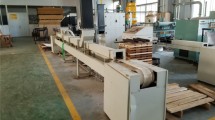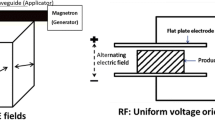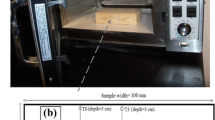Abstract
This study examined the impact of dielectric heating at radio frequencies (RF) as a pre-treatment on the kiln drying characteristics and end-quality of sub-alpine fir that is difficult to dry due to significant amount of wet pockets. Five plus a control group of 51×102 mm sub-alpine fir were RF heated at fixed power density (72 kW/m3), to the same core temperature (100°C) and at five time spans (15, 60, 75, 90, and 120 minutes) before conventional kiln drying was carried out. Air permeability tests were also performed on selected specimens. Results showed relatively higher permeability in almost all treatments. Drying rates above and below the fiber saturation point increased by 18–30% and 21–55%, respectively. All treatments resulted in improved lumber moisture gradients after kiln drying.
Zusammenfassung
Untersucht wurde in dieser Studie der Einfluss einer Vorbehandlung mittels Hochfrequenzerhitzung auf den Verlauf der technischen Trocknung und die Qualität des getrockneten Tannenholzes, das aufgrund hoher Nasskernanteile als schwierig zu trocknen gilt. Vor Durchführung der technischen Trocknung wurden fünf von sechs Gruppen (außer einer Kontrollgruppe) von Tannenschnittholz mit den Abmessungen 51×102 mm2 bei konstanter Leistungsdichte (72 kW/m3) mittels Hochfrequenz auf dieselbe Kerntemperatur (100°C) erhitzt. Diese wurde über fünf Zeitspannen (15, 60, 75, 90 und 120 Minuten) beibehalten. Des Weiteren wurden an ausgewählten Prüfkörpern Luftdurchlässigkeitsprüfungen durchgeführt. Die Ergebnisse ergaben bei nahezu allen Behandlungen eine relativ höhere Durchlässigkeit. Die Trocknungsgeschwindigkeiten über und unter Fasersättigung nahmen um 18–30 % bzw. 21–55 % zu. Alle Behandlungen ergaben nach der technischen Trocknung eine Verbesserung der Feuchtegradienten im Schnittholz.




Similar content being viewed by others
References
Avramidis S, Liu F, Neilson BJ (1994) Radio-frequency/vacuum drying of softwoods: drying of thick western red cedar with constant electrode voltage. For Prod J 44(1):41–45
Bramhall G, Wellwood RW (1976) Kiln drying of western Canadian lumber. Information Report, VP-X-159, 112 p
British Columbia Forest Service (2003) Timber supply and the mountain pine beetle infestation in British Columbia
Cai L, Oliveira LC (2008) A simulation of wet pocket lumber drying. Dry Technol 26(5):525–529
Hartley C, Davidson RW, Crandall BS (1961) Wetwood bacteria, and increased pH in trees. Report 2215, USDA Forest Products Laboratory, 35 p
Hong-Hai L, Qing-Wen W, Lin Y, Tao J, Yin-Chun C (2005) Modification of larch wood by intensive microwave irradiation. J For Res 16(3):237–240
Knudson RM, Chow S, Lau KK, Lougheed DE, Zaturecky I (2008) Extracting greater value from sub-alpine fir: some basic properties. For Prod J 58(1/2):31–39
Kollmann FFP, Côté WA (1968) Principles of wood science and technology, vol 1, Solid wood. Springer, Berlin, 592 p
Siau JF (1995) Wood: influence of moisture on physical properties. Department of Wood Science and Forest Products, Virginia Polytechnic Institute and State University, 227 p
Smith WJ (1970) Wood density survey in western Canada. Information Report VP-X- 66, Canadian Forestry Service, Western Forest Products Laboratory, Vancouver, BC, 29 p
Torgovnikov G, Vinden P (2000a) New wood-based materials “Torgvin” and 10–13, “Vintorg”. In: Proceedings of 5th pacific rim bio-based composites symposium, December 10–13, Canberra, Australia, pp 756–764
Torgovnikov G, Vinden P (2000b) Microwave modification of wood properties: improvements in wood permeability. International Research Group on Wood Preservation, 1RG31, IRG/WG-40181, May 14–19, Kona, Hawaii, USA
Vinden P, Torgovnikov G (2000) The physical manipulation of wood properties using microwave. In: Proceedings, international conference of IUFRO. The future of Eucalypts for wood production, Tasmania, Australia, March 19–24, pp 240–247
Zhang Y, Cai L (2008) Impact of heating speed on permeability of sub-alpine fir. Wood Sci Technol 42(3):241–250
Author information
Authors and Affiliations
Corresponding author
Rights and permissions
About this article
Cite this article
Abubakari, A., Avramidis, S. & Oliveira, L.C. Impact of radio frequency heating pre-treatment on the kiln drying characteristics of sub-alpine fir. Eur. J. Wood Prod. 70, 245–251 (2012). https://doi.org/10.1007/s00107-011-0546-y
Received:
Published:
Issue Date:
DOI: https://doi.org/10.1007/s00107-011-0546-y




